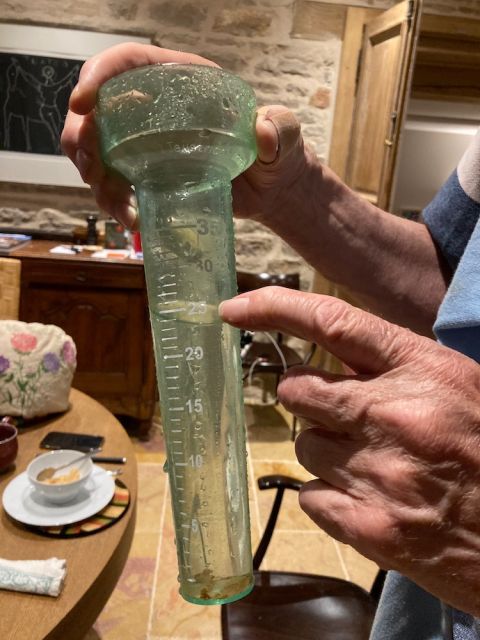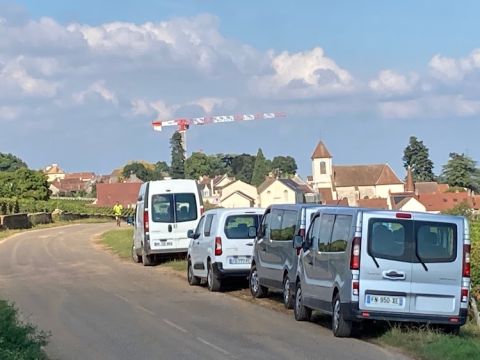On Sunday 19 September and all of the next day the mood in Burgundy was subdued, morose even. Low cloud carpeted the famous Côte d’Or and rain unremittingly pelted grapes in vineyards that, in the new normal of our warmer climate, would have been picked weeks ago. Some parts of Burgundy saw 45 mm (1.8 in) of rain on the 2021 crop in a single day. At Cellier aux Moines in Givry, owner Philippe Pascal pointed out the next day, in heavy rain, that they had started the harvest in 2020 exactly one month earlier.
Raymond Dureuil was born in 1942, has worked in the vineyards of Rully in the Côte Chalonnaise all his life, and says he has never known as bad a vintage as 2021. Three nights of devastating frost in early April robbed him and his son Vincent, now in charge of Domaine Dureuil-Janthial, of 80% of the potential 2021 crop.
This was followed by snow, and then an unusually cool, damp, cloudy summer during which the threat of mildew was ever-present, putting extreme pressure on the increasing proportion of growers who have foresworn the easy but damaging-in-the-long term route of spraying systemic fungicides on the vines. The son of one prominent organic vigneron in Alsace apparently told a sommelier friend, surely flippantly, ‘vintage charts should be easy for 2021: just avoid organic wines’.
In these conditions, grape ripening has been painfully slow. Hence the relatively late harvest. After the frosts had destroyed so much of the initial crop, thereby unlocking some financial compensation from the French minister of agriculture, there was talk of a second crop on the vines. But, as Vincent Dureuil pointed out as rain drenched his courtyard, ‘the second crop is a myth’. It’s true that the vine’s natural defence is to sprout forth a second lot of tiny berries, but they generally fail to ripen fully in time to be any use.
It was Burgundy’s white wine crop that suffered most because Chardonnay vines bud earlier than the Pinot Noir vines responsible for red burgundy, so they were more vulnerable to the frost. Like many producers in the Côte Chalonnaise to the south of the Côte d’Or, Dureuil-Janthial normally produce more white wine than red so Vincent’s gloom was understandable. At his neighbour Domaine Belleville, I was told that they have no white wine left to sell. I’m afraid that French white wine prices are surely bound to rise, for understandable reasons.
The southern half of the Côte d’Or, the Côte de Beaune where the great majority of the region’s white wine is produced, suffered more losses to frost, and more imperfect berries, than the Côte de Nuits in the north. And yet another complicating factor for the 2021 grape harvest is the shortage of pickers. Some proprietors clearly felt forced, perhaps by the demands of manpower, to pick in the rain – and rain in a wine region at harvest time is as depressing as rain in a ski resort during the winter season.
According to vigneron folklore, the autumn equinox on 21 September always signals a change in the weather and indeed by the time I got to the vineyards of the Côte de Nuits on Wednesday 22 September the sun had come out and the harvest was in full swing. The mood seemed incalculably different from the despondency that seemed to have settled on the sodden streets of Beaune where we had lunch on the Sunday.
All the pickers I saw from Wednesday onwards looked happy, even euphoric, enlivened by blue skies and sunshine warm enough to encourage quite a few bare chests as well as head coverings.
There is something so satisfyingly elemental about picking grapes, even if the Burgundian vignerons’ tendency to train bunches close to the ground is potentially back-breaking. This is a great time of year for van hirers. The green of the vines on the Côte d’Or is punctuated by white vans, and people-carriers to whose windows, this year, COVID-safe rules had been taped. I saw no masks in the vineyards of Morey-St-Denis where I was based, but pickers were expected to wear them when being transported to and from the vines.
It was quite spooky how rapidly the vineyards emptied of people on the stroke of noon. One change the pandemic has wrought is on the tradition of pickers eating together. Rather than providing giant quantities of food to be eaten communally, domaine owners are now more likely to provide individual lunch packs provided by outside caterers. Less folklorique than the old days perhaps but vignerons’ wives today are more likely to be in full-time jobs than to be waiting at home for a chance to stir the pot once a year.
Pickers at the grand cru Clos de Tart, now owned by French mega-businessman François Pinault, were treated to lunch at the smart hotel-restaurant Castel de Très Girard, just a hobble down Morey’s main village street from the vineyard.
One or two picking teams had finished by the Thursday 23 September and drove through the village honking their horns triumphantly.
I fear the reputation of 2021 is likely to be dogged by the record small quantity and ungenerous summer. But the grapes I saw going into the fermentation vats looked good and healthy (this was a year when sorting tables were essential) and several growers made the point that 2021 is likely to be a vintage in which we can enjoy a return to the sort of burgundy that was typically produced before climate change took full effect.
The last few vintages in Burgundy have been so warm that the Pinot Noir grapes especially have reached almost dangerous levels of ripeness, making concentrated wines more alcoholic that the Burgundian norm. Alcohol levels well above 14% have been known. It is not uncommon to encounter Burgundians acknowledging that the old system whereby the vineyards that ripen most reliably are the most valued may be a candidate for revision.
It’s quite possible that those connoisseurs who treasure the delicacy and perfume that used to distinguish red burgundy will find 2021 particularly to their liking. Whenever I asked growers about the potential alcohol levels in their 2021 grapes, they tended to be a relatively modest, but by no means worryingly low, between 12.2 and 13.5%.
For Pierre de Benoist, who looks after Domaine A & P de Villaine in Bouzeron on behalf of his uncle Aubert de Villaine of the world-famous Domaine de la Romanée-Conti, 2021 will be ‘a vintage that sorts the men from the boys, a vintage that’s typically Bourguignon, not Mediterranean’.
The new winemaker at Domaine Georges de Vogüé in Chambolle-Musigny couldn’t wait to get started on his debut vintage there. ‘The grapes are relatively small, so there will be less juice, but it will signal a return to classicism.’
Welcome classicism perhaps, but any moderation of Burgundy’s recent jaw-dropping price inflation seems all too unlikely.
Some just-affordable burgundies
These prices may look high, but so are those of Pinot Noirs of similar quality from Oregon, New Zealand and Australia.
White
Dom Bachelet-Monnot 2018 Bourgogne Blanc
£19.18 Justerinis
Benjamin Leroux 2018 and 2019 Bourgogne Blanc
£25 Berry Bros & Rudd
Jean-Philippe Fichet, Vieilles Vignes 2018 Bourgogne Blanc
£27.50 Berry Bros & Rudd
Red
Dom Tollot-Beaut 2018 Bourgogne Rouge
£22.99 Davy’s, £25 Berry Bros & Rudd
Benjamin Leroux 2018 Bourgogne Rouge
£25 Berry Bros & Rudd
Dom Thibault Liger-Belair, Les Grands Chaillots 2018 Bourgogne Rouge
£29.95 The Whisky Exchange
Dom Monthelie-Douhairet-Porcheret, Cuvée Miss Armande 2019 Monthelie
£31.50 Emile Wines
Dom Decelle & Fils, Les Beaumonts 2019 Chorey-lès-Beaune
£32.65 Haynes Hanson & Clark
International stockists on Wine-Searcher.com.

















